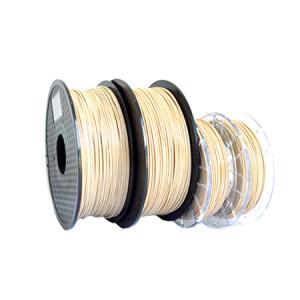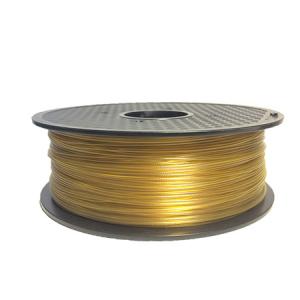MK10 Extruder
Makerbot did start the MK series. The first commercial version was the MK4 on the Cupcake circa 2009. MK4 was hand built with nichrome wire heaters and prone to all kinds of failures. They only worked with ABS and 3mm filament
It used a laser cut ring of acrylic super glued to a 608 skate bearing and an aluminum GT2 belt pulley for gripper teeth. Adjustment of pinch depth was critical or else it would slip or crack the acrylic idler. The PTFE insulators leaked, the nichrome wires shorted, it barely worked. If you were really skilled, you can make them work. I actually own 2 working ones for historical reference. This is a non-stepper system. It used a DC geared motor to drive and because the reduction ratio was so high, retraction was never used. It ran at a fixed ~2-3 RPM and thus extrusion was on/off and no acceleration.
MK5 Was a complete redesign and had huge nozzles and a thick PTFE liner. It used 2 large power resistors in parallel for heating and was prone to failure. I too still have working examples. This used a delrin adjustable plunger prone to wear that pressed the filament into the drive gear. Still used the same DC motor from MK4, but all new laser cut acrylic design. This all came about the time of the Thing-O-Matic printer release.
MK6 was the first stepper extruder sold as a kit that I know of (however Repraps had also started using them probably before). This came after the release of the T-O-M as an add-on upgrade. It replaced the stock MK5 motor with a big honking stepper and driver.
Mk6+ was the first cartridge heater hotend sold in kit form. The MK5/MK6 heater block was stainless steel, where MK6+ upgrade kit was an aluminum block that was slightly smaller, a lot lighter, and had the now standard 1/4 inch heater cartridge. MK6+ could be used on a DC extruder feeder setup(MK5 feeder) but most people were fully into the stepper because of a known failure where the DC motors had oil on the commutator of the DC motor that retained the carbon brushes dust thus partially shorting com segments. This in turn blew up the h-bridges on the expensive $90 extruder controller board.
MK7 was the first extruder you folks would think looks familiar. It was the first move to 1.75mm filament dedicated extruders. While a MK6+kit had parts to adapt to 1.75mm filament, it never worked well at all and was really a failure. MK7 was sold as an upgrade to all kits. It was all metal thermal barrier, printed PLA or ABS. Again, MK6+ and lower was generally 3mm filament, really made for ABS, didn't natively even print PLA during that time period. The biggest drawback was the MK7 feeder was a plunger with fixed distance washers for the preload. No V groove bearing, none of the stuff you see today. The plungers wore out and then they began to slip and grind filament
Again, this is all Thing-O-Matic and Cupcake era. Other than a few clones, there really was no third party market in the US at this time. You either had a MakerBot or some other Reprap based kit. Wanhao, FlashForge- they didn't even exist and if they did, weren't talked about like now.
MK8 was the all new dual extruder setup on the MakerBot Replicator. The cooling bar was thicker than the MK7 but the same all metal thermal barrier and supposedly, the MK8 has slightly different nozzle geometry internally and externally. The feeder was same as MK7 with a delrin plunger and had all the same problems.
Replicator2 was released as a single extruder version of the Replicator, but an all new all metal frame, the black stealth look. Still used a plunger drive.
Over time, the extruder was upgraded to the lever arm system you might recognize now as being very similar to current versions.
On the Wanhao side, this is where it got interesting.
The Wanhao Duplicator 3 was the first version I even know about. I assume D1 and D2 were derived from the T-O-M family.
Duplicator 3 was derived from the original wooden MakerBot replicator. The extruders were an upgrade popular at that time using V-groove 623 bearings as a fixed pinch idler. It was called Mk8. It is different from the MakerBot MK8 in almost every way.
The thermal barrier was PTFE lined with a 3mm OD, 2mm ID liner that extended into the special nozzle that looked like MK8 but had 3mm internal bore for the liner. The thermal barrrier was threaded and used 2 jam nuts above and below the cooling bar that was not threaded. It was common for folks changing nozzles to accidentally spin the thermal barrier tube loosening the nuts. This lead to both a bad seal of the nozzle to barrier inside the heater block and resulting mess, but also a very hard time of adjusting the dual nozzle heights. Because of the thinner liner, while MK9 was not as fast as a genuine MakerBot all metal real MK8, the Wanhao MK8/ hotend and thermal barrier could extruder faster than MK10.
MK9 was a MK8 hotend, cooling bar, thermal barrier, and nozzle, but the new feeder with spring lever we know on all current models. This is why it's confusing, MK9 was a feeder upgrade, not a hotend change.
MK10 was a complete change of the hotend. MK10 uses smooth OD thermal barriers with a larger 4mmOD 2mm ID PTFE liner. MK10 also uses M7 threads, vs the M6 of all previous models. This is because a 4mm PTFE liner is barely enough metal to make the outer tube with m6 threads. MK10 is completely incompatible with all previous hotend parts. Every part is different. Mk10 still uses MK9 feeder parts.
MK 11 on the D6 is just a MK10 nozzle and thermal barrier, but a different heater block and the cooling bar is part of the D6 central cross. Again, the only real difference is MK11 is a different heater block, and that's to adapt a different and longer heater cartridge and slide in thermocouple. MK11 still uses MK9 plastic feeder parts.
CR-10 Extruder
Upgrade your Creality 3D Printer Extruder with our New "Metal Aluminium Anodized" Upgrade Kit.
The kits include all the necessary screws & parts needed to directly replace your old original weak creality plastic extruder.
All you do is unbolt the old original creality plastic extruder & screw in the new "Metal Extruder" and your ready to start printing.
The advantages of a metal extruder is you have better stronger pressure pushing the filament into the printer nozzle and so will improve on the printers performance. Our extruder kits have an adjustable bolt so that you can adjust the pressure of the extruder gear as needed.









